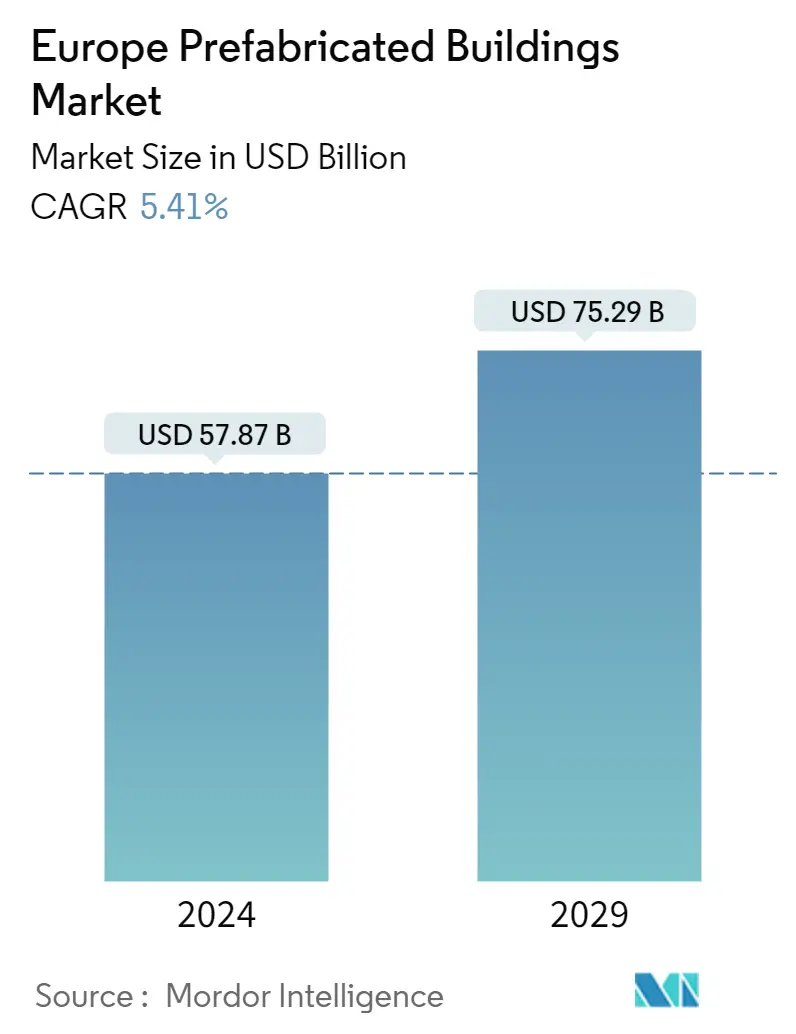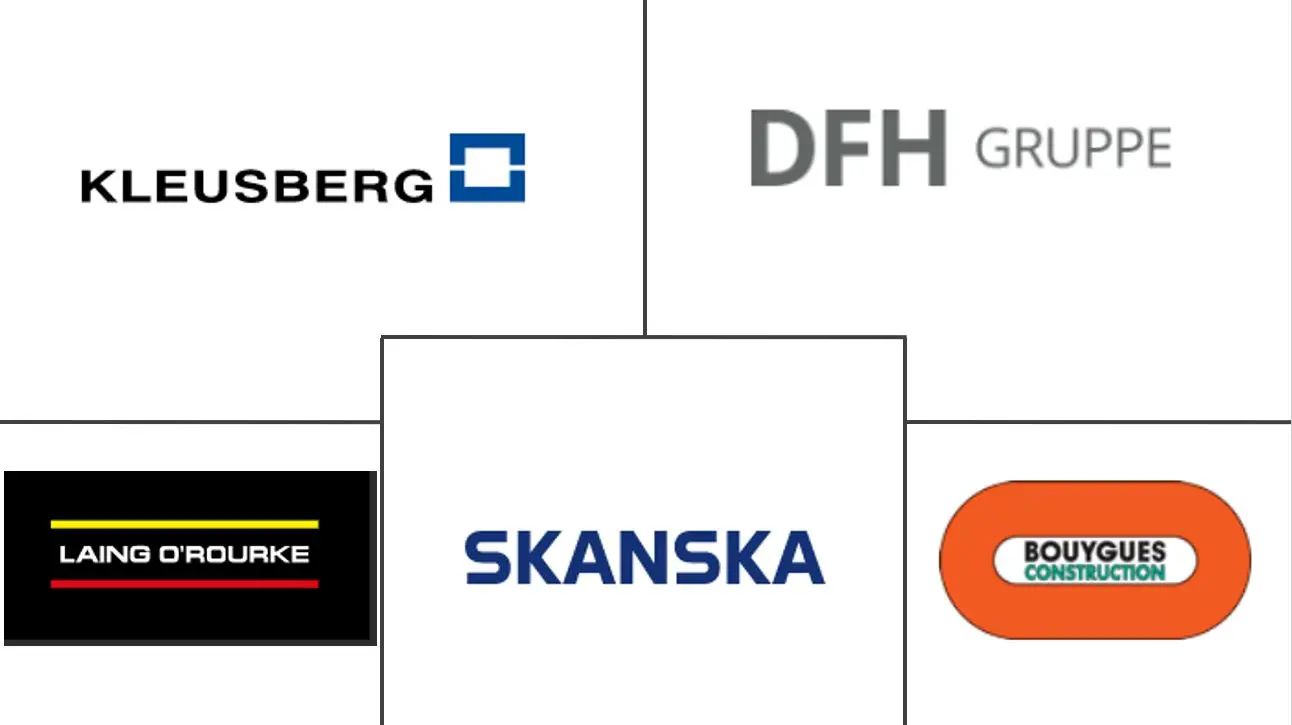Market Size of Europe Prefabricated Buildings Industry

| Study Period | 2020 - 2029 |
| Market Size (2024) | USD 57.87 Billion |
| Market Size (2029) | USD 75.29 Billion |
| CAGR (2024 - 2029) | 5.41 % |
| Fastest Growing Market | North America |
| Largest Market | North America |
Major Players
*Disclaimer: Major Players sorted in no particular order |
Europe Prefabricated Buildings Market Analysis
The Europe Prefabricated Buildings Market size is estimated at USD 57.87 billion in 2024, and is expected to reach USD 75.29 billion by 2029, growing at a CAGR of 5.41% during the forecast period (2024-2029).
The outbreak of the COVID-19 pandemic has led to severe uncertainty for vendors and contractors in the construction industry across Europe. Several construction companies shut down their projects due to lockdowns and restrictions. However, due to immediate requirements for hospitals and quarantine sectors, the demand for prefabricated materials witnessed an increase. Since a high workforce is required for traditional construction, opting for prefabricated buildings became an optimum solution during the pandemic.
The market is expanding as the demand for higher-quality, environment-friendly homes rise across the continent, with the United Kingdom and Germany accounting for the highest proportions. The adoption of additive manufacturing in Europe is expected to significantly boost the prefabricated construction sector. Companies embrace environment-friendly products and production practices to differentiate themselves from the competition. The introduction of energy-absorbing materials such as micro dwellings has resulted from focusing on energy efficiency.
Prefabricated housing demand is rising as the building technique's advantages are increasingly being leveraged by new home buyers in an improving economic and demographically charged marketplace. By the end of 2022, an estimated 70,100 units are anticipated to be sold across six Northern European countries, with the German demand representing a sizeable level, particularly for turnkey solutions.
Europe Prefabricated Buildings Industry Segmentation
The European prefabricated buildings market covers growing trends and projects like commercial, residential, and industrial construction. The report also covers the industry and materials used, like concrete, timber, glass, metal, and other types. The market scope has been extended to provide insights at the regional level by segmenting across geography. Along with the report's scope, it also analyzes the key players and the competitive landscape in the market. The impact of COVID-19 has also been incorporated and considered during the study.
| By Application | |
| Residential | |
| Commercial | |
| Other Applications (Industrial, Institutional, and Infrastructure) |
| By Geography | |
| Belgium | |
| Finland | |
| France | |
| Germany | |
| Italy | |
| Rest of Europe |
Europe Prefabricated Buildings Market Size Summary
The European prefabricated buildings market is experiencing significant growth, driven by the increasing demand for high-quality, environmentally friendly construction solutions. The market's expansion is largely attributed to the rising adoption of prefabricated building techniques, which offer advantages such as reduced construction time and labor costs. The COVID-19 pandemic further accelerated this trend, as the need for rapid construction of hospitals and quarantine facilities highlighted the benefits of prefabricated materials. Countries like the United Kingdom and Germany are leading the charge, with a growing emphasis on sustainable building practices and the integration of additive manufacturing technologies. The market is characterized by a diverse range of players, including major construction firms like Laing O-Rourke and Bouygues Construction, who are actively investing in innovative prefabricated solutions to maintain a competitive edge.
The market landscape is further shaped by the increasing popularity of timber and steel constructions, particularly in regions such as France and Russia, where environmental considerations and infrastructure investments are driving demand. In Italy, the use of cross-laminated timber is on the rise, reflecting a broader trend towards sustainable building materials. The prefabricated housing sector is also witnessing a surge in demand, with companies like Ilke Homes and Legal & General leading the way in the UK by producing modular homes to address housing shortages. Despite the fragmented nature of the market, with no single player dominating, the competitive environment is fostering innovation and collaboration among key industry stakeholders. As the market continues to evolve, the focus on energy efficiency and sustainable construction practices is expected to play a pivotal role in shaping the future of prefabricated buildings in Europe.
Europe Prefabricated Buildings Market Size - Table of Contents
-
1. MARKET INSIGHTS
-
1.1 Current Market Scenario
-
1.2 Technological Trends
-
1.3 Insights into Supply Chain/Value Chain Analysis of the Prefabricated Buildings Industry
-
1.4 Brief on Different Structures Used in the Prefabricated Buildings Industry
-
1.5 Cost Structure Analysis of the Prefabricated Buildings Industry
-
1.6 Impact of COVID-19 on the Market
-
-
2. MARKET SEGMENTATION
-
2.1 By Application
-
2.1.1 Residential
-
2.1.2 Commercial
-
2.1.3 Other Applications (Industrial, Institutional, and Infrastructure)
-
-
2.2 By Geography
-
2.2.1 Belgium
-
2.2.2 Finland
-
2.2.3 France
-
2.2.4 Germany
-
2.2.5 Italy
-
2.2.6 Rest of Europe
-
-
Europe Prefabricated Buildings Market Size FAQs
How big is the Europe Prefabricated Buildings Market?
The Europe Prefabricated Buildings Market size is expected to reach USD 57.87 billion in 2024 and grow at a CAGR of 5.41% to reach USD 75.29 billion by 2029.
What is the current Europe Prefabricated Buildings Market size?
In 2024, the Europe Prefabricated Buildings Market size is expected to reach USD 57.87 billion.

